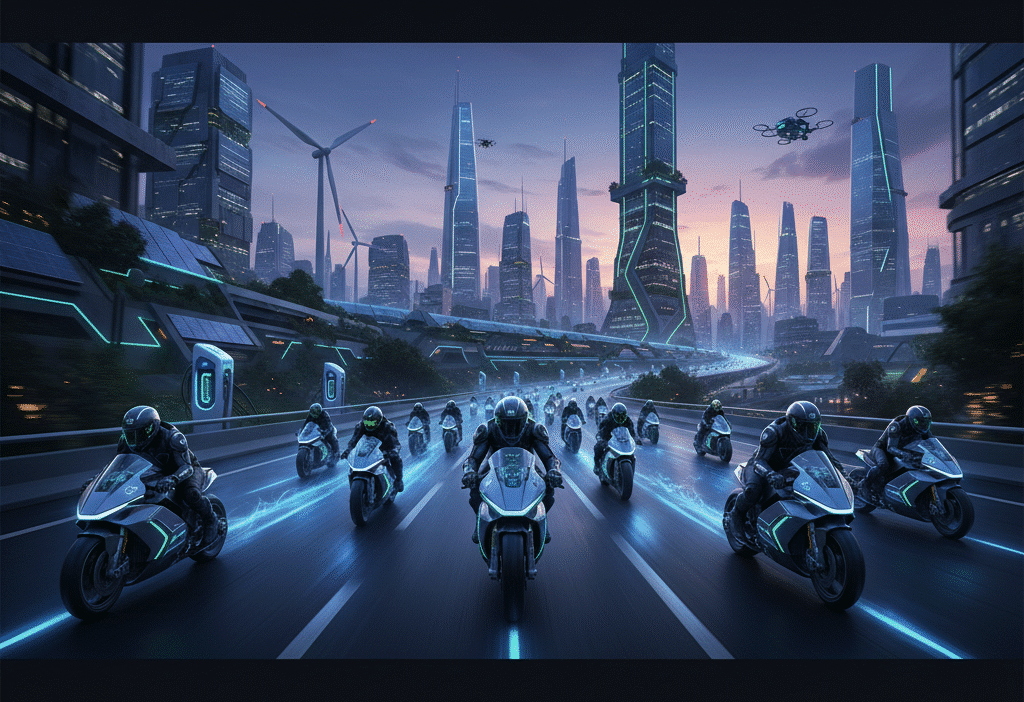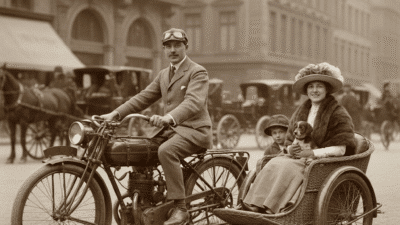The open road beckons, a timeless call to freedom and adventure. For generations, this call has been answered by the rumble and roar of internal combustion engines. But a new sound, or rather, the thrilling absence of it, is rapidly redefining the experience. We are witnessing nothing less than a revolution on two wheels: the rise of electric motorcycles. This isn’t just a trend; it’s a fundamental shift, propelled by breathtaking technological advancements, a growing environmental consciousness, and an insatiable desire for an even purer, more exhilarating ride. Imagine instant torque, silent acceleration, and a connection to the road unlike anything before. Electric motorcycles are no longer a niche curiosity; they are a powerful, undeniable force shaping the future of mobility, offering a unique blend of performance, sustainability, and sheer riding pleasure.
The Electrifying Performance: Beyond the Roar
Forget any preconceived notions about electric vehicles being sluggish or uninspiring. Modern electric motorcycles deliver a performance profile that is, in many ways, superior to their gasoline-powered counterparts. The most striking difference? Instant torque. Unlike internal combustion engines that need to build RPMs to reach peak power, electric motors deliver 100% of their torque from a standstill. This translates into jaw-dropping acceleration that can pin you back in your seat (or on your seat!) with exhilarating immediacy.
Take, for instance, models like the Zero SR/S or the LiveWire S2 Del Mar. These machines aren’t just fast; they’re effortlessly quick. Pulling away from a traffic light or slingshotting out of a corner becomes a smooth, silent surge of power. Riders often describe the experience as “flying” or “gliding,” a sensation unmarred by gear changes or engine vibration. This direct, linear power delivery offers a unique connection to the road, allowing riders to focus purely on the ride itself. The absence of a clutch and gearbox also simplifies the riding experience, making it more accessible to a wider range of riders while still offering deep engagement for seasoned enthusiasts.
The competitive arena has also seen the electrifying potential. The FIM MotoE World Cup, a support series to MotoGP, showcases the incredible capabilities of electric racing machines. These bikes demonstrate that electric power can compete at the highest levels, pushing boundaries and inspiring innovations that eventually trickle down to consumer models. The rapid evolution of electric vehicle technology, often accelerated by the demands of motorsport, is a testament to the adage that racing improves the breed. Indeed, many of the advanced materials and aerodynamic principles we see in electric bikes today derive from the relentless pursuit of speed and efficiency on the track, much like how racing technologies shape everyday cars.
| Pros | Cons |
|---|---|
| – Instant torque and exhilarating acceleration | – Higher upfront purchase cost |
| – Zero tailpipe emissions, reduced carbon footprint | – Limited range compared to some ICE bikes |
| – Significantly lower maintenance requirements | – Longer “refueling” times (charging) |
| – Quieter operation, reducing noise pollution | – Charging infrastructure still developing in some areas |
| – Government incentives and tax benefits | – Battery degradation over extended periods |

Silence is Golden: The Environmental & Urban Advantage
One of the most profound impacts of electric motorcycles is their environmental footprint – or lack thereof. With zero tailpipe emissions, these machines contribute significantly to cleaner air, particularly in congested urban environments. This isn’t just about meeting regulatory standards; it’s about fundamentally transforming our cities into quieter, healthier places. Imagine a city where the pervasive drone of traffic is replaced by the gentle hum of electric motors and the ambient sounds of urban life.
Beyond air quality, the reduced noise pollution is a game-changer. For riders, it means a more serene journey, allowing them to hear the wind, the road, and their own thoughts, rather than being constantly bombarded by engine noise. For communities, it means less disturbance and a more peaceful coexistence with two-wheeled transport. This benefit is especially pronounced in densely populated areas where noise is a constant irritant.
The move towards electric two-wheelers aligns perfectly with global initiatives for sustainable mobility. As cities grapple with pollution, traffic congestion, and climate change, electric motorcycles offer an elegant solution. They’re compact, efficient, and increasingly integrated into smart city concepts. From urban commuters seeking a nimble, eco-friendly way to navigate gridlock to adventure riders wanting to explore nature without leaving a carbon footprint, electric motorcycles represent a compelling part of the green revolution. Their role in reducing reliance on fossil fuels further underscores their importance in paving the way for a more sustainable future.
Technological Marvels: Batteries, Motors, and Connectivity
The rapid evolution of electric motorcycles is intrinsically linked to breakthroughs in battery technology, motor design, and digital connectivity. These aren’t just incremental improvements; they are foundational shifts that make today’s EV bikes viable and exciting.
At the heart of every electric motorcycle lies its battery pack. Advances in lithium-ion technology have dramatically increased energy density, meaning more power and longer range packed into smaller, lighter units. We’re seeing greater efficiency, faster charging capabilities, and improved longevity. Companies are constantly pushing the boundaries, with some even exploring solid-state batteries that promise even greater leaps in performance and safety.
The motors themselves are engineering marvels. Permanent Magnet Synchronous Motors (PMSM) and Internal Permanent Magnet (IPM) motors are incredibly efficient, powerful, and compact. They convert electrical energy into mechanical energy with minimal loss, contributing to the impressive range and acceleration figures we now see. These motors are often liquid-cooled to maintain optimal performance and durability, even under strenuous riding conditions.
Charging infrastructure, while still evolving, has made significant strides. Home charging (Level 1 and Level 2) is convenient for overnight top-ups, while public charging networks with Level 2 and DC fast-charging stations are becoming more widespread. Some manufacturers are even exploring swappable battery systems, a particularly interesting solution for urban commuting, allowing riders to quickly exchange a depleted battery for a fully charged one in minutes.
Beyond the core powertrain, modern electric motorcycles are packed with smart technology. App integration allows riders to monitor battery status, plan routes, adjust riding modes, and even receive over-the-air (OTA) updates for their bike’s software. Traction control, ABS, and regenerative braking systems are standard, enhancing safety and efficiency. This seamless blend of mechanical prowess and digital intelligence creates a riding experience that is both sophisticated and intuitive.

Range Anxiety and Infrastructure: Addressing the Challenges
One of the most common concerns for prospective electric motorcycle owners is “range anxiety” – the fear of running out of power far from a charging point. While it’s a valid concern, the industry is making significant strides to mitigate it. Battery technology is constantly improving, leading to increased ranges that make longer journeys more feasible. Many contemporary electric motorcycles now offer real-world ranges suitable for daily commutes and even weekend excursions, often exceeding 100-150 miles on a single charge for larger models.
Beyond battery capacity, the expanding charging infrastructure is crucial. Public charging stations, both dedicated motorcycle chargers and universal EV chargers, are becoming more prevalent in urban centers, along major highways, and at popular destinations. Businesses are increasingly installing charging points to attract EV users. Moreover, the convenience of home charging cannot be overstated. Plugging in your motorcycle overnight, just like your smartphone, means starting every day with a “full tank.”
Innovative solutions are also emerging. Battery swap networks, championed by companies like Gogoro in Taiwan, offer a revolutionary approach to refueling, allowing riders to swap a depleted battery for a fully charged one in seconds. While not yet widespread globally for larger motorcycles, this concept highlights the potential for creative solutions to charging challenges. As more manufacturers embrace standardization and governments invest in green infrastructure, the charging landscape will only improve, making electric motorcycle ownership increasingly practical and worry-free.

The Diverse World of Electric Two-Wheelers: Something for Everyone
The beauty of the electric motorcycle revolution is its incredible diversity. What started as a niche market has blossomed into a vibrant ecosystem offering a two-wheeled EV for almost every taste and purpose.
- Sportbikes and Naked Bikes: For thrill-seekers, brands like Zero Motorcycles (e.g., SR/S, SR/F) and LiveWire (S2 Del Mar, ONE) deliver breathtaking acceleration, sharp handling, and cutting-edge design. These bikes often challenge, and in some cases surpass, the performance of their gasoline counterparts, all while offering a uniquely smooth and silent rush.
- Cruisers: Brands like Harley-Davidson (via LiveWire) are bringing electric power to the classic cruiser segment, offering a relaxed riding position with instant, effortless torque perfect for urban cruising or highway touring.
- Off-Road and Dirt Bikes: For adventurers who want to explore trails without disturbing wildlife or leaving a carbon footprint, electric dirt bikes are phenomenal. Companies like Sur-Ron, Stark Future (with their VARG model), and Cake offer lightweight, powerful, and incredibly fun off-road machines that redefine the dirt riding experience. Their instant torque makes climbing steep inclines surprisingly easy.
- Commuters and Scooters: The urban jungle is arguably where electric two-wheelers shine brightest. Electric scooters and smaller commuter motorcycles offer nimble handling, zero emissions, and ultra-low running costs, making them ideal for navigating city traffic. Many brands offer stylish and practical options for daily use.
- Adventure Bikes: While still a developing segment, manufacturers are exploring electric adventure motorcycles capable of tackling diverse terrains and longer distances. The instant torque is a huge advantage for technical off-road sections, and the quiet operation allows for a more immersive experience in nature.
This expanding variety means that whether you’re a seasoned rider looking for the next thrill, a daily commuter seeking an efficient and eco-friendly solution, or an off-road enthusiast wanting to explore silently, there’s an electric motorcycle designed with you in mind. This rapid expansion in models is a clear indicator that the electric motorcycle market is maturing and diversifying at an incredible pace, mirroring the broader evolution of vehicle design from basic utility to specialized segments, much like the evolution of car design from 1900 to 2025.
Maintenance, Longevity, and Cost of Ownership
One of the often-overlooked but significant advantages of electric motorcycles is their dramatically simplified maintenance schedule. Gone are the days of oil changes, spark plug replacements, air filter cleanings, and clutch adjustments. Electric powertrains have far fewer moving parts than internal combustion engines. This translates into less time in the workshop and more time on the road.
While you won’t be checking and changing your motorcycle oil on an EV, essential maintenance tasks still remain. You’ll still need to ensure your tires are in good condition and correctly inflated, and know when to replace motorcycle tires. Brake pads and fluid will require regular inspection and occasional replacement, as will suspension components. The battery pack is the heart of the system and while designed for longevity, its health is paramount. Proper charging habits and avoiding extreme temperatures can extend its lifespan.
Looking at the overall cost of ownership, electric motorcycles offer compelling savings over time. While the initial purchase price can sometimes be higher than comparable gasoline models (though this gap is rapidly closing), the operational costs are significantly lower. Electricity is generally much cheaper than gasoline, especially if you charge at home during off-peak hours. Reduced maintenance bills further contribute to long-term savings. Furthermore, many regions offer government incentives, tax credits, or rebates for purchasing electric vehicles, making the initial investment more palatable. When you factor in these long-term savings, an electric motorcycle often proves to be a more economical choice over its lifespan.
Government Incentives and Regulatory Support
The global push towards electrification is not just consumer-driven; it’s heavily supported by governments worldwide. Recognizing the environmental and economic benefits, many nations and local authorities have implemented a range of incentives and regulatory measures to encourage the adoption of electric motorcycles.
These incentives can include:
- Tax Credits and Rebates: Direct financial breaks at the point of sale or tax deductions for purchasing an electric vehicle.
- Purchase Subsidies: Grants or subsidies that reduce the upfront cost of the motorcycle.
- Reduced Registration Fees: Lower annual fees compared to gasoline motorcycles.
- Parking Privileges: Dedicated parking spots or reduced parking fees in urban areas.
- HOV Lane Access: Permission to use high-occupancy vehicle lanes, even with just one rider, to bypass traffic.
- Exemption from Urban Emission Zones: Access to city centers where internal combustion vehicles might be restricted or charged a fee.
These governmental programs play a vital role in accelerating the transition to electric mobility. They help offset the initial investment cost, making electric motorcycles more accessible to a broader market. Moreover, ongoing investments in charging infrastructure development, backed by public funds, are crucial for alleviating range anxiety and making EV ownership a truly seamless experience. As environmental regulations tighten globally, the landscape for electric vehicles, including motorcycles, will only become more favorable, solidifying their position as the future of personal transport.

The Future is Electric: Innovations on the Horizon
The electric motorcycle industry is still in its nascent stages, yet the pace of innovation is breathtaking. What we see today is just the beginning. The future promises even more exciting developments that will further enhance performance, range, and the overall riding experience.
Imagine solid-state batteries becoming commercially viable, offering significantly greater energy density, faster charging times, and enhanced safety compared to current lithium-ion technology. This could unlock ranges that truly rival gasoline bikes, eliminating range anxiety for good. Wireless charging technology, allowing riders to simply park their bikes over a charging pad, could also revolutionize convenience.
Further advancements in motor efficiency and power delivery are inevitable. We might see integrated motor-wheel designs, further reducing unsprung weight and improving handling. Lightweight materials, such as advanced composites and alloys, will continue to make bikes lighter and more agile.
Connectivity will deepen, with motorcycles becoming even more integrated into the smart ecosystem. We could see advanced rider-assistance systems, intelligent route planning that optimizes for charging stops, and even vehicle-to-grid (V2G) capabilities, allowing your motorcycle’s battery to feed power back into your home or the grid during peak demand. The potential for augmented reality displays in helmets, offering navigation and telemetry data directly in the rider’s line of sight, is also a fascinating prospect. The trends we observe in the broader automotive sector, like the focus on autonomy and connectivity, are equally applicable to two-wheelers, shaping the future of the automotive industry.
The sheer excitement surrounding these innovations means the electric motorcycle landscape will continue to evolve rapidly, offering riders an increasingly sophisticated, thrilling, and sustainable way to explore the world.

Conclusion
The rise of electric motorcycles is more than just a technological shift; it’s a paradigm change for motorcycling enthusiasts and commuters alike. From the exhilarating, silent surge of instant torque to the profound environmental benefits of zero emissions, these machines are redefining what it means to ride. We’ve explored the electrifying performance that challenges and often surpasses traditional bikes, the peace and quiet they bring to our communities, and the incredible technological strides that power them. We’ve confronted the challenges of range anxiety and infrastructure, highlighting the ongoing solutions, and marveled at the sheer diversity of models now available. With robust government support and an accelerating pace of innovation, the future of two-wheeled travel is undeniably electric.
Embrace the quiet revolution. Experience the thrill of unadulterated power and the profound connection to the road that only an electric motorcycle can offer. The open road is calling, and now, it’s quieter, cleaner, and more exhilarating than ever before. It’s time to join the ride into the future.
Frequently Asked Questions
What are the main benefits of owning an electric motorcycle?
The primary benefits include instant and smooth torque for exhilarating acceleration, zero tailpipe emissions for environmental friendliness, significantly reduced maintenance needs due to fewer moving parts, and quieter operation that enhances the riding experience and reduces noise pollution.
How does the range of electric motorcycles compare to gasoline bikes?
While older models had limited range, modern electric motorcycles now offer practical ranges, often exceeding 100-150 miles on a single charge for many models, making them suitable for daily commutes and many touring needs. Battery technology is continually improving, pushing these figures higher.
Is the charging infrastructure for electric motorcycles sufficient?
The charging infrastructure is rapidly expanding. While still developing in some rural areas, urban centers and major highways increasingly offer Level 2 and DC fast-charging stations. Home charging provides the convenience of starting every ride with a full battery.
Are electric motorcycles more expensive than gasoline motorcycles?
Initially, electric motorcycles often have a higher upfront purchase price. However, this gap is narrowing. When considering the total cost of ownership, electric bikes often prove more economical in the long run due to lower “fuel” costs (electricity), reduced maintenance expenses, and available government incentives or tax credits.
What kind of maintenance do electric motorcycles require?
Electric motorcycles require significantly less maintenance than gasoline bikes. You won’t have oil changes, spark plug replacements, or clutch adjustments. Regular maintenance focuses on wear items like tires, brakes, and suspension components. Battery health monitoring and software updates are also part of the routine care.
Can electric motorcycles be used for off-road riding?
Absolutely! Electric dirt bikes and off-road models are gaining popularity for their instant torque, which is excellent for tackling challenging terrain, and their quiet operation, which allows riders to enjoy nature without disturbance. Brands like Sur-Ron and Stark Future offer powerful off-road EVs.
What government incentives are available for purchasing an electric motorcycle?
Incentives vary by region but can include tax credits, purchase rebates, reduced registration fees, parking privileges, and access to HOV lanes. These programs aim to make electric motorcycle ownership more affordable and appealing.



